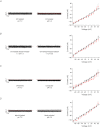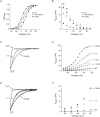Altered Kv3.3 channel gating in early-onset spinocerebellar ataxia type 13
- PMID: 22289912
- PMCID: PMC3413486
- DOI: 10.1113/jphysiol.2012.228205
Altered Kv3.3 channel gating in early-onset spinocerebellar ataxia type 13
Abstract
Mutations in Kv3.3 cause spinocerebellar ataxia type 13 (SCA13). Depending on the causative mutation, SCA13 is either a neurodevelopmental disorder that is evident in infancy or a progressive neurodegenerative disease that emerges during adulthood. Previous studies did not clarify the relationship between these distinct clinical phenotypes and the effects of SCA13 mutations on Kv3.3 function. The F448L mutation alters channel gating and causes early-onset SCA13. R420H and R423H suppress Kv3 current amplitude by a dominant negative mechanism. However, R420H results in the adult form of the disease whereas R423H produces the early-onset, neurodevelopmental form with significant clinical overlap with F448L. Since individuals with SCA13 have one wild type and one mutant allele of the Kv3.3 gene, we analysed the properties of tetrameric channels formed by mixtures of wild type and mutant subunits. We report that one R420H subunit and at least one R423H subunit can co-assemble with the wild type protein to form active channels. The functional properties of channels containing R420H and wild type subunits strongly resemble those of wild type alone. In contrast, channels containing R423H and wild type subunits show significantly altered gating, including a hyperpolarized shift in the voltage dependence of activation, slower activation, and modestly slower deactivation. Notably, these effects resemble the modified gating seen in channels containing a mixture of F448L and wild type subunits, although the F448L subunit slows deactivation more dramatically than the R423H subunit. Our results suggest that the clinical severity of R423H reflects its dual dominant negative and dominant gain of function effects. However, as shown by R420H, reducing current amplitude without altering gating does not result in infant onset disease. Therefore, our data strongly suggest that changes in Kv3.3 gating contribute significantly to an early age of onset in SCA13.
Figures







Similar articles
-
Functional effects of spinocerebellar ataxia type 13 mutations are conserved in zebrafish Kv3.3 channels.BMC Neurosci. 2010 Aug 16;11:99. doi: 10.1186/1471-2202-11-99. BMC Neurosci. 2010. PMID: 20712895 Free PMC article.
-
KCNC3(R420H), a K(+) channel mutation causative in spinocerebellar ataxia 13 displays aberrant intracellular trafficking.Neurobiol Dis. 2014 Nov;71:270-9. doi: 10.1016/j.nbd.2014.08.020. Epub 2014 Aug 22. Neurobiol Dis. 2014. PMID: 25152487 Free PMC article.
-
Kv3.3 channels harbouring a mutation of spinocerebellar ataxia type 13 alter excitability and induce cell death in cultured cerebellar Purkinje cells.J Physiol. 2014 Jan 1;592(1):229-47. doi: 10.1113/jphysiol.2013.264309. Epub 2013 Nov 11. J Physiol. 2014. PMID: 24218544 Free PMC article.
-
Kv3.3 potassium channels and spinocerebellar ataxia.J Physiol. 2016 Aug 15;594(16):4677-84. doi: 10.1113/JP271343. Epub 2015 Nov 15. J Physiol. 2016. PMID: 26442672 Free PMC article. Review.
-
Potential Benefit of Channel Activators in Loss-of-Function Primary Potassium Channelopathies Causing Heredoataxia.Cerebellum. 2024 Apr;23(2):833-837. doi: 10.1007/s12311-023-01584-8. Epub 2023 Jul 17. Cerebellum. 2024. PMID: 37460907 Review.
Cited by
-
Cerebellar Kv3.3 potassium channels activate TANK-binding kinase 1 to regulate trafficking of the cell survival protein Hax-1.Nat Commun. 2021 Mar 19;12(1):1731. doi: 10.1038/s41467-021-22003-8. Nat Commun. 2021. PMID: 33741962 Free PMC article.
-
Modeling Neurodegenerative Spinocerebellar Ataxia Type 13 in Zebrafish Using a Purkinje Neuron Specific Tunable Coexpression System.J Neurosci. 2019 May 15;39(20):3948-3969. doi: 10.1523/JNEUROSCI.1862-18.2019. Epub 2019 Mar 12. J Neurosci. 2019. PMID: 30862666 Free PMC article.
-
A recurrent de novo mutation in KCNC1 causes progressive myoclonus epilepsy.Nat Genet. 2015 Jan;47(1):39-46. doi: 10.1038/ng.3144. Epub 2014 Nov 17. Nat Genet. 2015. PMID: 25401298 Free PMC article.
-
Genetic neurological channelopathies: molecular genetics and clinical phenotypes.J Neurol Neurosurg Psychiatry. 2016 Jan;87(1):37-48. doi: 10.1136/jnnp-2015-311233. Epub 2015 Nov 11. J Neurol Neurosurg Psychiatry. 2016. PMID: 26558925 Free PMC article. Review.
-
Rare Gain-of-Function KCND3 Variant Associated with Cerebellar Ataxia, Parkinsonism, Cognitive Dysfunction, and Brain Iron Accumulation.Int J Mol Sci. 2021 Jul 31;22(15):8247. doi: 10.3390/ijms22158247. Int J Mol Sci. 2021. PMID: 34361012 Free PMC article.
References
-
- Baukrowitz T, Yellen G. Modulation of K+ current by frequency and external [K+]: a tale of two inactivation mechanisms. Neuron. 1995;15:951–960. - PubMed
Publication types
MeSH terms
Substances
Supplementary concepts
Grants and funding
LinkOut - more resources
Full Text Sources
Other Literature Sources
Molecular Biology Databases

